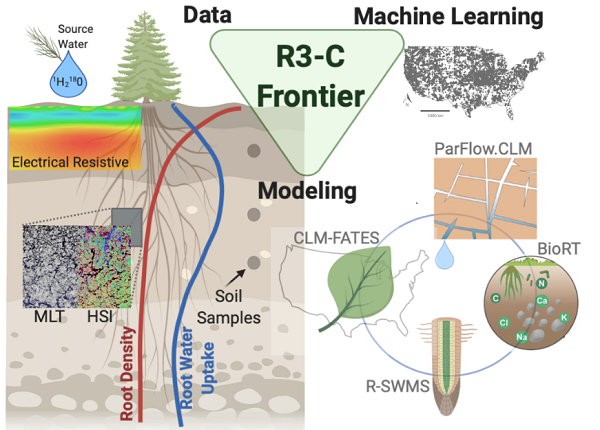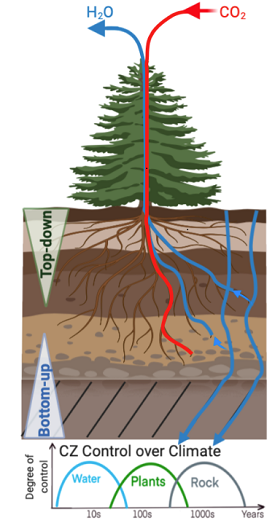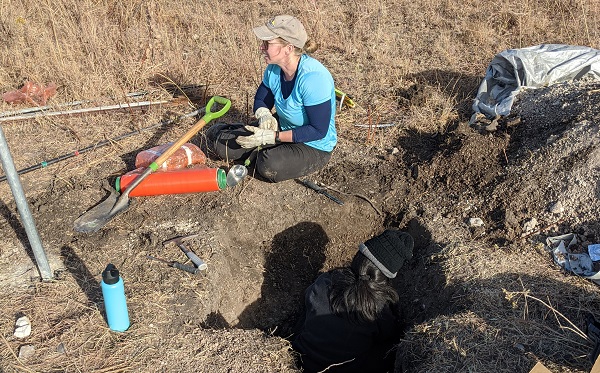The R3-C Frontier
Scientific studies continue to show we are in a new epoch on Earth, the Anthropocene, a period of time where human activity plays a controlling role in the cycling of water, carbon, and nutrients. Interestingly, it is the combined interaction of the climate, bedrock (its physical and chemical makeup), and vegetation (via root exploration for water and nutrients) that controls the movement and magnitude of water and carbon fluxes. These fluxes in turn influence climate by altering important factors such as greenhouse gas concentrations (e.g., H2O, CO2).
To understand how land will interact with climate in the future requires a better understanding of how landscape bedrock versus vegetation regulates water and carbon storage and movement, determining which locations are more likely to change, and assessing how below ground and vegetation properties influence climate conditions that, in turn, govern vegetation establishment and distribution. Hence, we are studying the R3-C Frontier: Roots, Regolith, Rock and Climate!

We will collect data, use machine learning approaches, and model to understand how roots and rocks interact to sculpt the subsurface, controlling water and carbon fluxes and thus the degree of subsurface-atmospheric coupling.
To achieve this goal requires synthesizing existing datasets, collecting new data, and training teams of people in the fields of water science, geochemistry, soil science, geophysics, ecology, and Earth system modeling. This project will include 28 undergraduate students, four graduate students, and three postdoc scholars across seven universities to collectively explore how the interaction of plant roots and bedrock have changed water and carbon movement between the land and atmosphere in the Anthropocene. Data collection will begin in summer 2022!

Fundamentally, this work will address two questions: when and to what degree does bedrock exert more control than roots on subsurface and atmosphere coupling, and what impact does this have on water and carbon fluxes? Using an interdisciplinary approach that incorporates new data collection, data harvesting, machine learning, and numerical modeling, we will address these questions by: 1) illuminating mechanisms by which bedrock and fracture distributions govern the development of preferential flow paths and acquiring process-based understanding of these processes from the plot to watershed to continental scales; 2) revealing the depth, degree, and timing of coupling between the subsurface and atmosphere and its impact on water storage and fluxes; 3) uncovering how root abundance and activities interact with rock to shape the subsurface structure and associated carbon stores and the conditions under which root water uptake leverages resultant subsurface structure to meet transpiration fluxes; 4) incorporating measurements rarely used in ecosystem science (e.g., 3D geophysical data, structural soil pore data) to transform our understanding of where and when changes in the subsurface occur and how these processes govern sources of root water uptake; 5) integrating global in situ and remotely sensed datasets via machine learning to discern emergent patterns in subsurface structure controlled by biotic and abiotic processes; and 6) providing a causal and comprehensive framework of hydro-biogeochemical linkages to lay the foundation for predicting how climatic conditions and subsurface structure regulate hydrological flow and carbon transformations and fluxes.
To accomplish this work, we will leverage existing datasets and collect new data from the NSF Critical Zone Cluster Networks (CZCNs), National Ecological Observatory Network (NEON), and Long Term Ecological Research (LTER) programs. Our modeling framework enhances our capacity to parameterize multiple relevant process models, upscales point-scale measurements to the continental scale, and provides a holistic understanding of factors that control Earth system processes from the terrestrial subsurface to the atmosphere.
Project supported by NSF-GEO:
Project PI's:
Dr. Pam Sullivan (Oregon State University),
Dr. Li Li (Pennsylvania State University),
Dr. Sharon Billings (University of Kansas),
Dr. Lejo Flores (Idaho State University),
Dr. Kamini Singha (Colorado School of Mines),
Dr. Dan Hirmas (Cal Riverside),
Dr. Hoori Ajami (Cal Riverside),
Dr. Jesse Nippert (Kansas State University)
Project Graduate Students:
Students are being recruited now!

Our fearless leader Pam in action (with Kayal digging down in the pit!).